University Business Analysis Report: Nintendo's Strategic Performance
VerifiedAdded on 2023/06/07
|13
|2539
|92
Report
AI Summary
This report offers a thorough business analysis of Nintendo, a prominent player in the video game industry. It begins with an executive summary of Nintendo's current business scenario and corporate strategy, highlighting its historical performance and recent developments like the Nintendo Switch. The report then delves into internal and external analyses, utilizing SWOT and PESTLE frameworks to assess the company's strengths, weaknesses, opportunities, and threats, as well as the political, economic, social, technological, environmental, and legal factors impacting its operations. A simplified business systems model is also presented to analyze the operations. The analysis identifies key strategic issues, such as competition from rival companies and the need for innovation and diversification. Based on the analysis, the report provides actionable recommendations for Nintendo, including a more targeted marketing strategy and the incorporation of innovative technologies. The conclusion emphasizes the importance of adapting to the dynamic video game industry to enhance its competitive positioning and profitability.

Running head: BUSINESS ANALYSIS OF NINTENDO
Business analysis of Nintendo
Name of the student:
Name of the university:
Author note:
Business analysis of Nintendo
Name of the student:
Name of the university:
Author note:
Paraphrase This Document
Need a fresh take? Get an instant paraphrase of this document with our AI Paraphraser
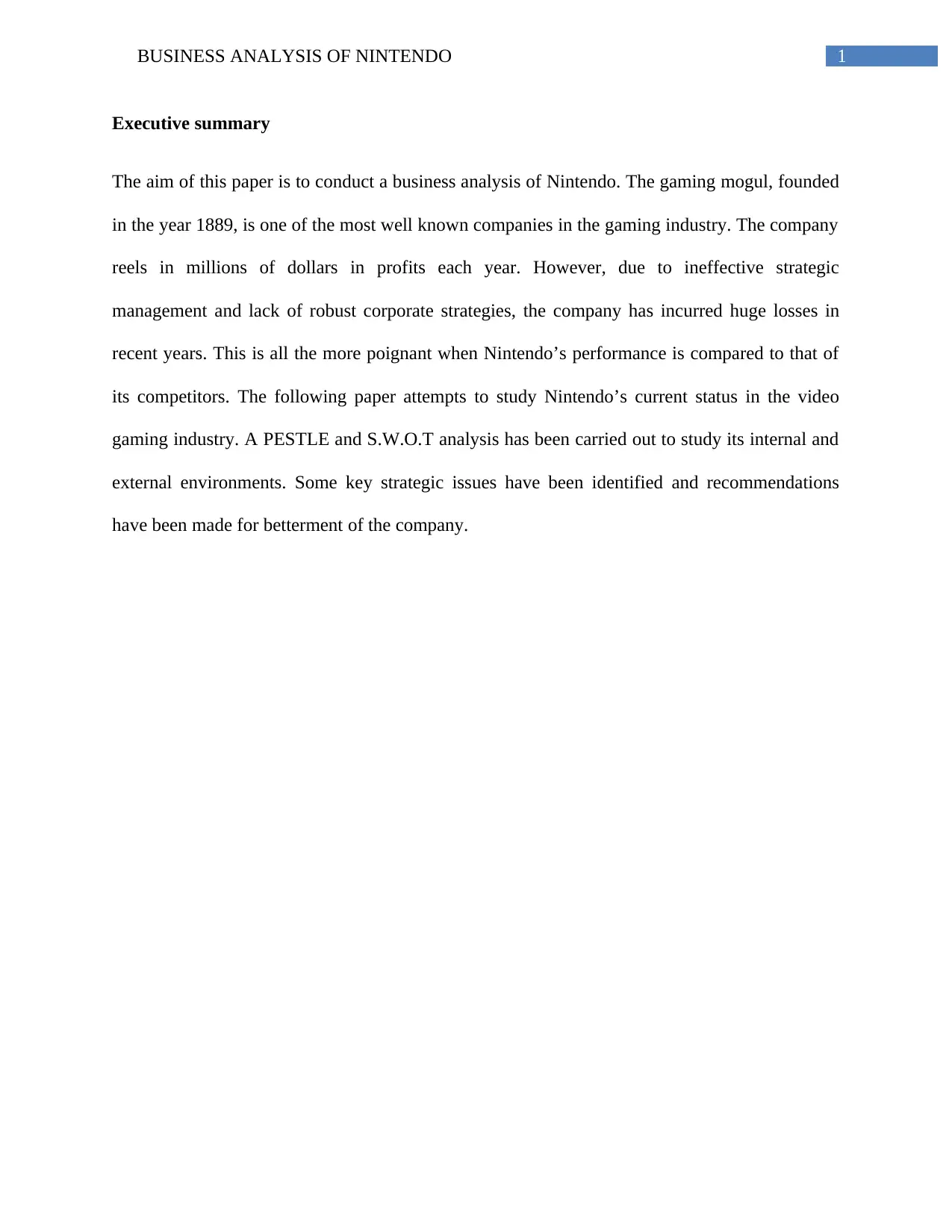
1BUSINESS ANALYSIS OF NINTENDO
Executive summary
The aim of this paper is to conduct a business analysis of Nintendo. The gaming mogul, founded
in the year 1889, is one of the most well known companies in the gaming industry. The company
reels in millions of dollars in profits each year. However, due to ineffective strategic
management and lack of robust corporate strategies, the company has incurred huge losses in
recent years. This is all the more poignant when Nintendo’s performance is compared to that of
its competitors. The following paper attempts to study Nintendo’s current status in the video
gaming industry. A PESTLE and S.W.O.T analysis has been carried out to study its internal and
external environments. Some key strategic issues have been identified and recommendations
have been made for betterment of the company.
Executive summary
The aim of this paper is to conduct a business analysis of Nintendo. The gaming mogul, founded
in the year 1889, is one of the most well known companies in the gaming industry. The company
reels in millions of dollars in profits each year. However, due to ineffective strategic
management and lack of robust corporate strategies, the company has incurred huge losses in
recent years. This is all the more poignant when Nintendo’s performance is compared to that of
its competitors. The following paper attempts to study Nintendo’s current status in the video
gaming industry. A PESTLE and S.W.O.T analysis has been carried out to study its internal and
external environments. Some key strategic issues have been identified and recommendations
have been made for betterment of the company.
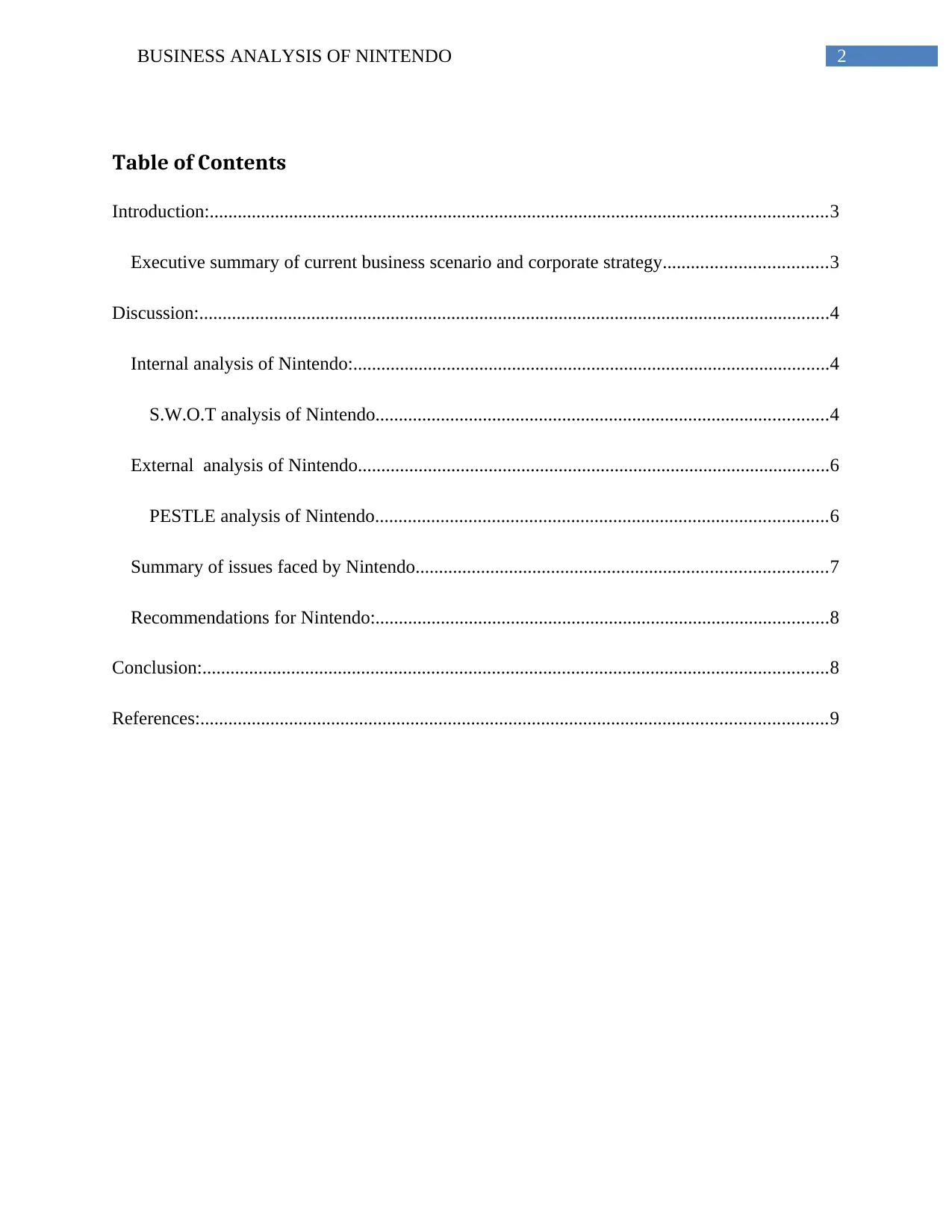
2BUSINESS ANALYSIS OF NINTENDO
Table of Contents
Introduction:....................................................................................................................................3
Executive summary of current business scenario and corporate strategy...................................3
Discussion:.......................................................................................................................................4
Internal analysis of Nintendo:......................................................................................................4
S.W.O.T analysis of Nintendo.................................................................................................4
External analysis of Nintendo.....................................................................................................6
PESTLE analysis of Nintendo.................................................................................................6
Summary of issues faced by Nintendo........................................................................................7
Recommendations for Nintendo:.................................................................................................8
Conclusion:......................................................................................................................................8
References:......................................................................................................................................9
Table of Contents
Introduction:....................................................................................................................................3
Executive summary of current business scenario and corporate strategy...................................3
Discussion:.......................................................................................................................................4
Internal analysis of Nintendo:......................................................................................................4
S.W.O.T analysis of Nintendo.................................................................................................4
External analysis of Nintendo.....................................................................................................6
PESTLE analysis of Nintendo.................................................................................................6
Summary of issues faced by Nintendo........................................................................................7
Recommendations for Nintendo:.................................................................................................8
Conclusion:......................................................................................................................................8
References:......................................................................................................................................9
⊘ This is a preview!⊘
Do you want full access?
Subscribe today to unlock all pages.

Trusted by 1+ million students worldwide
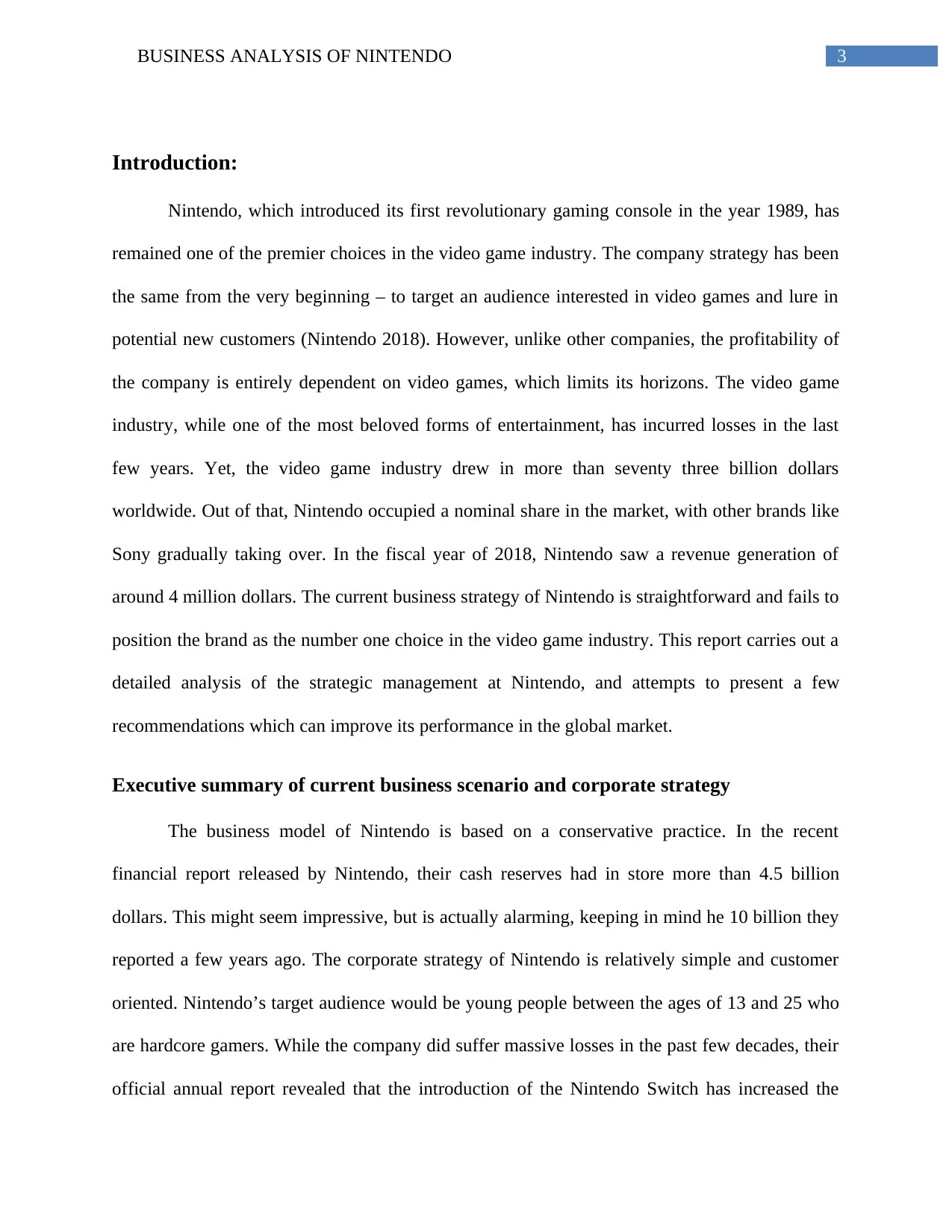
3BUSINESS ANALYSIS OF NINTENDO
Introduction:
Nintendo, which introduced its first revolutionary gaming console in the year 1989, has
remained one of the premier choices in the video game industry. The company strategy has been
the same from the very beginning – to target an audience interested in video games and lure in
potential new customers (Nintendo 2018). However, unlike other companies, the profitability of
the company is entirely dependent on video games, which limits its horizons. The video game
industry, while one of the most beloved forms of entertainment, has incurred losses in the last
few years. Yet, the video game industry drew in more than seventy three billion dollars
worldwide. Out of that, Nintendo occupied a nominal share in the market, with other brands like
Sony gradually taking over. In the fiscal year of 2018, Nintendo saw a revenue generation of
around 4 million dollars. The current business strategy of Nintendo is straightforward and fails to
position the brand as the number one choice in the video game industry. This report carries out a
detailed analysis of the strategic management at Nintendo, and attempts to present a few
recommendations which can improve its performance in the global market.
Executive summary of current business scenario and corporate strategy
The business model of Nintendo is based on a conservative practice. In the recent
financial report released by Nintendo, their cash reserves had in store more than 4.5 billion
dollars. This might seem impressive, but is actually alarming, keeping in mind he 10 billion they
reported a few years ago. The corporate strategy of Nintendo is relatively simple and customer
oriented. Nintendo’s target audience would be young people between the ages of 13 and 25 who
are hardcore gamers. While the company did suffer massive losses in the past few decades, their
official annual report revealed that the introduction of the Nintendo Switch has increased the
Introduction:
Nintendo, which introduced its first revolutionary gaming console in the year 1989, has
remained one of the premier choices in the video game industry. The company strategy has been
the same from the very beginning – to target an audience interested in video games and lure in
potential new customers (Nintendo 2018). However, unlike other companies, the profitability of
the company is entirely dependent on video games, which limits its horizons. The video game
industry, while one of the most beloved forms of entertainment, has incurred losses in the last
few years. Yet, the video game industry drew in more than seventy three billion dollars
worldwide. Out of that, Nintendo occupied a nominal share in the market, with other brands like
Sony gradually taking over. In the fiscal year of 2018, Nintendo saw a revenue generation of
around 4 million dollars. The current business strategy of Nintendo is straightforward and fails to
position the brand as the number one choice in the video game industry. This report carries out a
detailed analysis of the strategic management at Nintendo, and attempts to present a few
recommendations which can improve its performance in the global market.
Executive summary of current business scenario and corporate strategy
The business model of Nintendo is based on a conservative practice. In the recent
financial report released by Nintendo, their cash reserves had in store more than 4.5 billion
dollars. This might seem impressive, but is actually alarming, keeping in mind he 10 billion they
reported a few years ago. The corporate strategy of Nintendo is relatively simple and customer
oriented. Nintendo’s target audience would be young people between the ages of 13 and 25 who
are hardcore gamers. While the company did suffer massive losses in the past few decades, their
official annual report revealed that the introduction of the Nintendo Switch has increased the
Paraphrase This Document
Need a fresh take? Get an instant paraphrase of this document with our AI Paraphraser
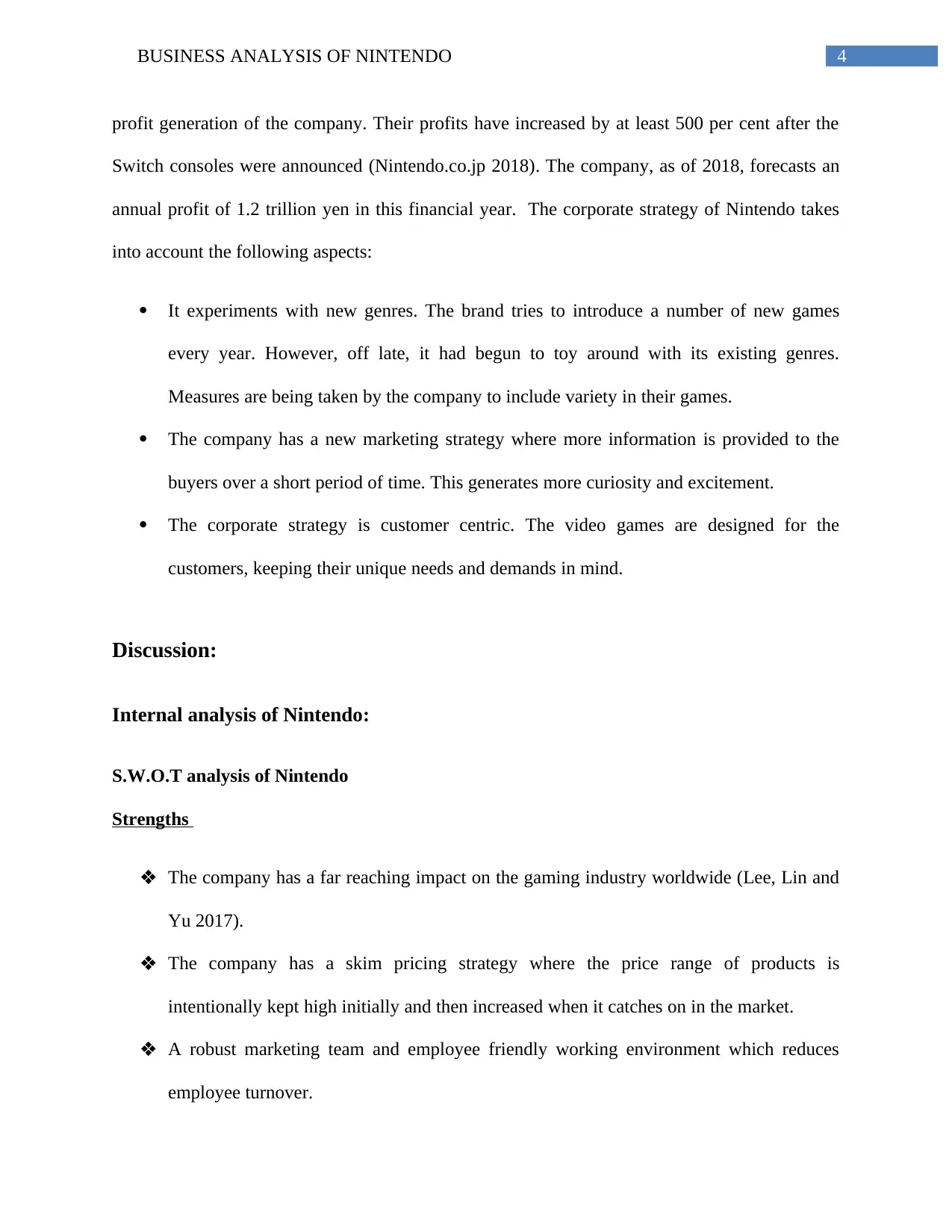
4BUSINESS ANALYSIS OF NINTENDO
profit generation of the company. Their profits have increased by at least 500 per cent after the
Switch consoles were announced (Nintendo.co.jp 2018). The company, as of 2018, forecasts an
annual profit of 1.2 trillion yen in this financial year. The corporate strategy of Nintendo takes
into account the following aspects:
It experiments with new genres. The brand tries to introduce a number of new games
every year. However, off late, it had begun to toy around with its existing genres.
Measures are being taken by the company to include variety in their games.
The company has a new marketing strategy where more information is provided to the
buyers over a short period of time. This generates more curiosity and excitement.
The corporate strategy is customer centric. The video games are designed for the
customers, keeping their unique needs and demands in mind.
Discussion:
Internal analysis of Nintendo:
S.W.O.T analysis of Nintendo
Strengths
The company has a far reaching impact on the gaming industry worldwide (Lee, Lin and
Yu 2017).
The company has a skim pricing strategy where the price range of products is
intentionally kept high initially and then increased when it catches on in the market.
A robust marketing team and employee friendly working environment which reduces
employee turnover.
profit generation of the company. Their profits have increased by at least 500 per cent after the
Switch consoles were announced (Nintendo.co.jp 2018). The company, as of 2018, forecasts an
annual profit of 1.2 trillion yen in this financial year. The corporate strategy of Nintendo takes
into account the following aspects:
It experiments with new genres. The brand tries to introduce a number of new games
every year. However, off late, it had begun to toy around with its existing genres.
Measures are being taken by the company to include variety in their games.
The company has a new marketing strategy where more information is provided to the
buyers over a short period of time. This generates more curiosity and excitement.
The corporate strategy is customer centric. The video games are designed for the
customers, keeping their unique needs and demands in mind.
Discussion:
Internal analysis of Nintendo:
S.W.O.T analysis of Nintendo
Strengths
The company has a far reaching impact on the gaming industry worldwide (Lee, Lin and
Yu 2017).
The company has a skim pricing strategy where the price range of products is
intentionally kept high initially and then increased when it catches on in the market.
A robust marketing team and employee friendly working environment which reduces
employee turnover.

5BUSINESS ANALYSIS OF NINTENDO
Weaknesses
The failure of the Wii was a major loss, as far as Nintendo’s present market situation is
concerned.
Marketing mistakes made by the company in the recent years cost them a few loyal
customers.
The failure to meet profit margins, unlike their competitors.
Lack of exciting and innovative new products which would appeal to new audiences.
Opportunities
The gaming industry is only gaining momentum in 2018. Nintendo has tremendous
opportunity to make it big in the industry, only if coupled with effective strategic
management.
With easy access to internet, the gaming industry has permeated the world of mobile
phones as well.
Threats
The only major threat to Nintendo’s success at present is that of competition from other
companies like Sony. Sony, which has garnered international reputation in this field,
promises better services and more technologically advanced products than Nintendo (Neil
et al. 2013).
Business systems model in Nintendo
The video gaming industry can be said to be a part of the Information Technology. As
such, the concept of business systems modeling may be used to analyze the operations at
Weaknesses
The failure of the Wii was a major loss, as far as Nintendo’s present market situation is
concerned.
Marketing mistakes made by the company in the recent years cost them a few loyal
customers.
The failure to meet profit margins, unlike their competitors.
Lack of exciting and innovative new products which would appeal to new audiences.
Opportunities
The gaming industry is only gaining momentum in 2018. Nintendo has tremendous
opportunity to make it big in the industry, only if coupled with effective strategic
management.
With easy access to internet, the gaming industry has permeated the world of mobile
phones as well.
Threats
The only major threat to Nintendo’s success at present is that of competition from other
companies like Sony. Sony, which has garnered international reputation in this field,
promises better services and more technologically advanced products than Nintendo (Neil
et al. 2013).
Business systems model in Nintendo
The video gaming industry can be said to be a part of the Information Technology. As
such, the concept of business systems modeling may be used to analyze the operations at
⊘ This is a preview!⊘
Do you want full access?
Subscribe today to unlock all pages.

Trusted by 1+ million students worldwide
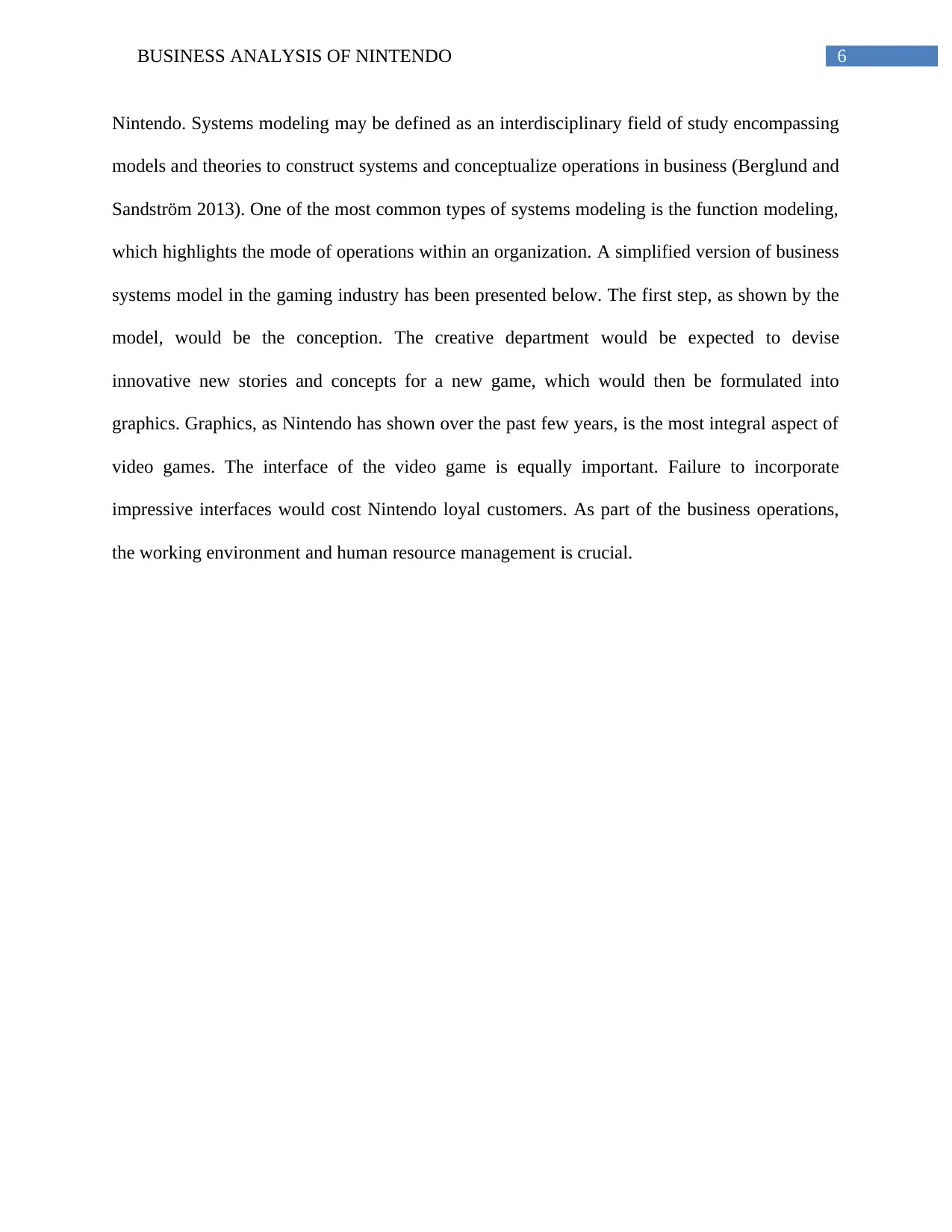
6BUSINESS ANALYSIS OF NINTENDO
Nintendo. Systems modeling may be defined as an interdisciplinary field of study encompassing
models and theories to construct systems and conceptualize operations in business (Berglund and
Sandström 2013). One of the most common types of systems modeling is the function modeling,
which highlights the mode of operations within an organization. A simplified version of business
systems model in the gaming industry has been presented below. The first step, as shown by the
model, would be the conception. The creative department would be expected to devise
innovative new stories and concepts for a new game, which would then be formulated into
graphics. Graphics, as Nintendo has shown over the past few years, is the most integral aspect of
video games. The interface of the video game is equally important. Failure to incorporate
impressive interfaces would cost Nintendo loyal customers. As part of the business operations,
the working environment and human resource management is crucial.
Nintendo. Systems modeling may be defined as an interdisciplinary field of study encompassing
models and theories to construct systems and conceptualize operations in business (Berglund and
Sandström 2013). One of the most common types of systems modeling is the function modeling,
which highlights the mode of operations within an organization. A simplified version of business
systems model in the gaming industry has been presented below. The first step, as shown by the
model, would be the conception. The creative department would be expected to devise
innovative new stories and concepts for a new game, which would then be formulated into
graphics. Graphics, as Nintendo has shown over the past few years, is the most integral aspect of
video games. The interface of the video game is equally important. Failure to incorporate
impressive interfaces would cost Nintendo loyal customers. As part of the business operations,
the working environment and human resource management is crucial.
Paraphrase This Document
Need a fresh take? Get an instant paraphrase of this document with our AI Paraphraser
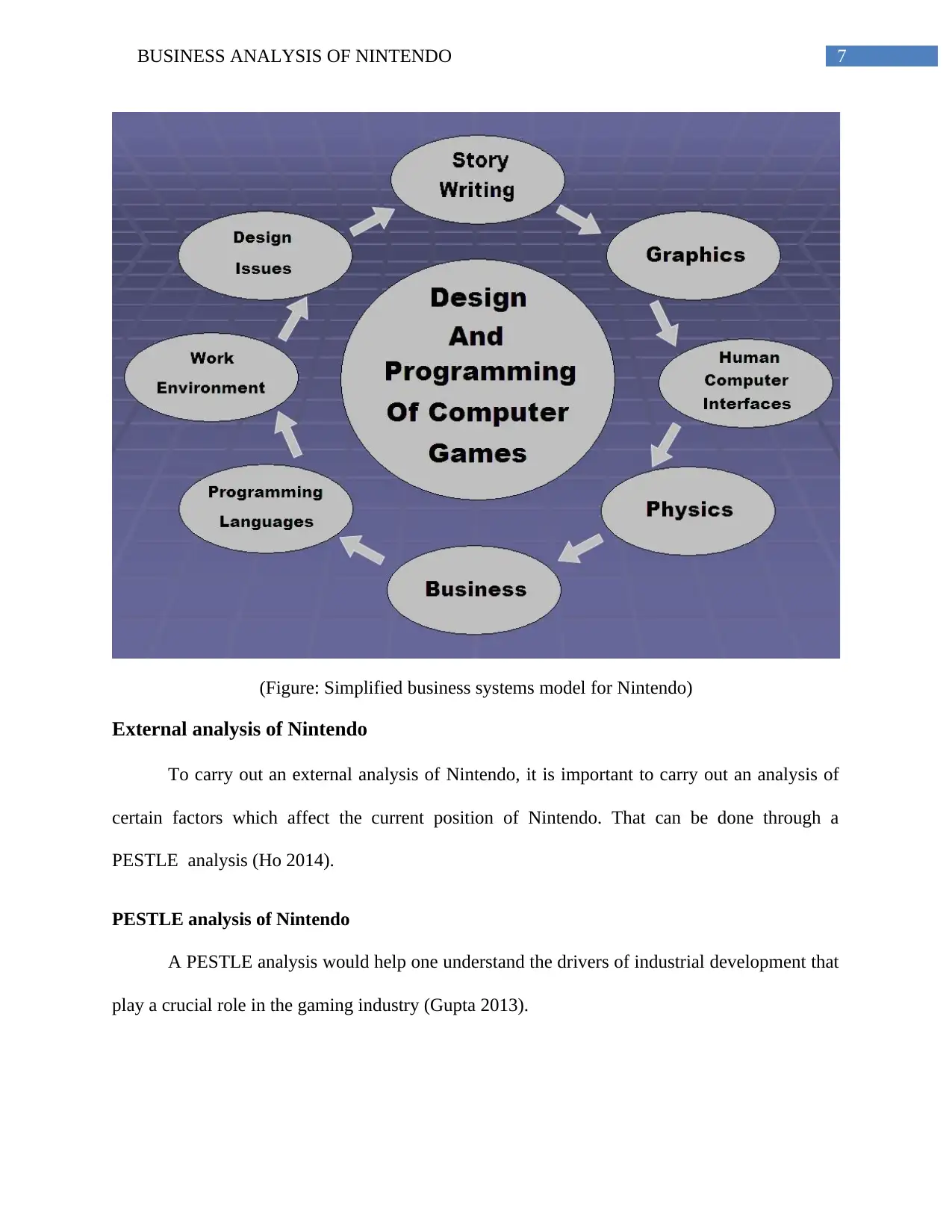
7BUSINESS ANALYSIS OF NINTENDO
(Figure: Simplified business systems model for Nintendo)
External analysis of Nintendo
To carry out an external analysis of Nintendo, it is important to carry out an analysis of
certain factors which affect the current position of Nintendo. That can be done through a
PESTLE analysis (Ho 2014).
PESTLE analysis of Nintendo
A PESTLE analysis would help one understand the drivers of industrial development that
play a crucial role in the gaming industry (Gupta 2013).
(Figure: Simplified business systems model for Nintendo)
External analysis of Nintendo
To carry out an external analysis of Nintendo, it is important to carry out an analysis of
certain factors which affect the current position of Nintendo. That can be done through a
PESTLE analysis (Ho 2014).
PESTLE analysis of Nintendo
A PESTLE analysis would help one understand the drivers of industrial development that
play a crucial role in the gaming industry (Gupta 2013).
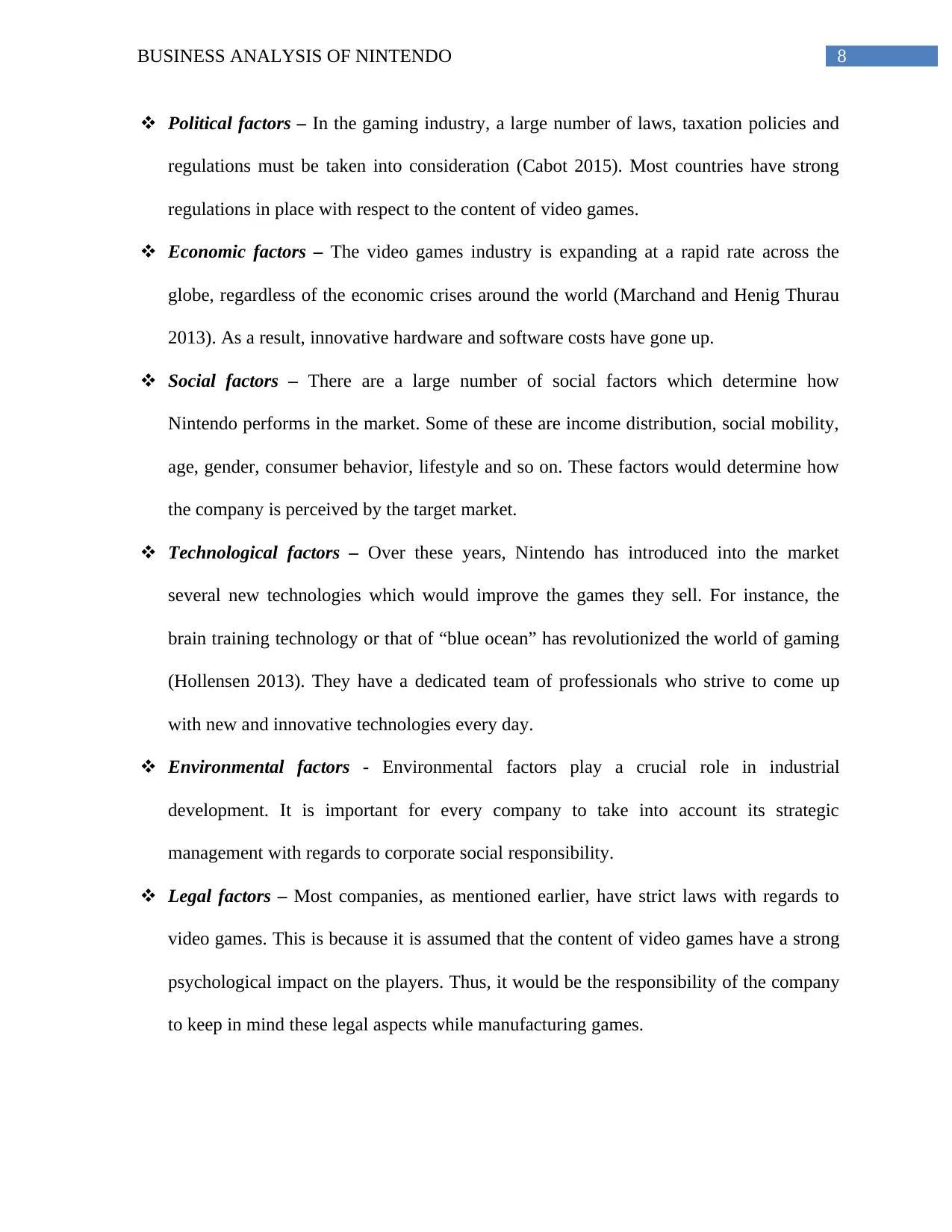
8BUSINESS ANALYSIS OF NINTENDO
Political factors – In the gaming industry, a large number of laws, taxation policies and
regulations must be taken into consideration (Cabot 2015). Most countries have strong
regulations in place with respect to the content of video games.
Economic factors – The video games industry is expanding at a rapid rate across the
globe, regardless of the economic crises around the world (Marchand and Henig Thurau
2013). As a result, innovative hardware and software costs have gone up.
Social factors – There are a large number of social factors which determine how
Nintendo performs in the market. Some of these are income distribution, social mobility,
age, gender, consumer behavior, lifestyle and so on. These factors would determine how
the company is perceived by the target market.
Technological factors – Over these years, Nintendo has introduced into the market
several new technologies which would improve the games they sell. For instance, the
brain training technology or that of “blue ocean” has revolutionized the world of gaming
(Hollensen 2013). They have a dedicated team of professionals who strive to come up
with new and innovative technologies every day.
Environmental factors - Environmental factors play a crucial role in industrial
development. It is important for every company to take into account its strategic
management with regards to corporate social responsibility.
Legal factors – Most companies, as mentioned earlier, have strict laws with regards to
video games. This is because it is assumed that the content of video games have a strong
psychological impact on the players. Thus, it would be the responsibility of the company
to keep in mind these legal aspects while manufacturing games.
Political factors – In the gaming industry, a large number of laws, taxation policies and
regulations must be taken into consideration (Cabot 2015). Most countries have strong
regulations in place with respect to the content of video games.
Economic factors – The video games industry is expanding at a rapid rate across the
globe, regardless of the economic crises around the world (Marchand and Henig Thurau
2013). As a result, innovative hardware and software costs have gone up.
Social factors – There are a large number of social factors which determine how
Nintendo performs in the market. Some of these are income distribution, social mobility,
age, gender, consumer behavior, lifestyle and so on. These factors would determine how
the company is perceived by the target market.
Technological factors – Over these years, Nintendo has introduced into the market
several new technologies which would improve the games they sell. For instance, the
brain training technology or that of “blue ocean” has revolutionized the world of gaming
(Hollensen 2013). They have a dedicated team of professionals who strive to come up
with new and innovative technologies every day.
Environmental factors - Environmental factors play a crucial role in industrial
development. It is important for every company to take into account its strategic
management with regards to corporate social responsibility.
Legal factors – Most companies, as mentioned earlier, have strict laws with regards to
video games. This is because it is assumed that the content of video games have a strong
psychological impact on the players. Thus, it would be the responsibility of the company
to keep in mind these legal aspects while manufacturing games.
⊘ This is a preview!⊘
Do you want full access?
Subscribe today to unlock all pages.

Trusted by 1+ million students worldwide
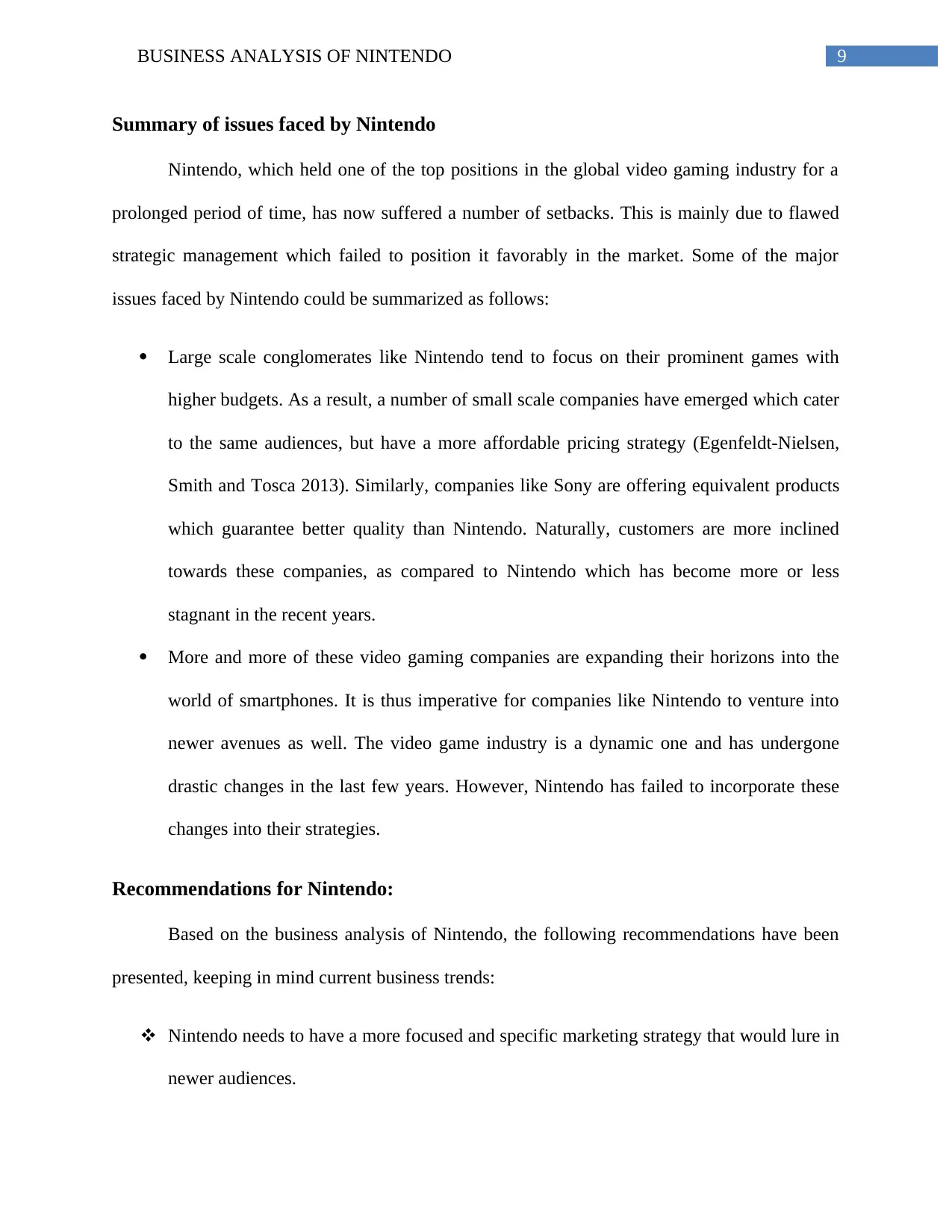
9BUSINESS ANALYSIS OF NINTENDO
Summary of issues faced by Nintendo
Nintendo, which held one of the top positions in the global video gaming industry for a
prolonged period of time, has now suffered a number of setbacks. This is mainly due to flawed
strategic management which failed to position it favorably in the market. Some of the major
issues faced by Nintendo could be summarized as follows:
Large scale conglomerates like Nintendo tend to focus on their prominent games with
higher budgets. As a result, a number of small scale companies have emerged which cater
to the same audiences, but have a more affordable pricing strategy (Egenfeldt-Nielsen,
Smith and Tosca 2013). Similarly, companies like Sony are offering equivalent products
which guarantee better quality than Nintendo. Naturally, customers are more inclined
towards these companies, as compared to Nintendo which has become more or less
stagnant in the recent years.
More and more of these video gaming companies are expanding their horizons into the
world of smartphones. It is thus imperative for companies like Nintendo to venture into
newer avenues as well. The video game industry is a dynamic one and has undergone
drastic changes in the last few years. However, Nintendo has failed to incorporate these
changes into their strategies.
Recommendations for Nintendo:
Based on the business analysis of Nintendo, the following recommendations have been
presented, keeping in mind current business trends:
Nintendo needs to have a more focused and specific marketing strategy that would lure in
newer audiences.
Summary of issues faced by Nintendo
Nintendo, which held one of the top positions in the global video gaming industry for a
prolonged period of time, has now suffered a number of setbacks. This is mainly due to flawed
strategic management which failed to position it favorably in the market. Some of the major
issues faced by Nintendo could be summarized as follows:
Large scale conglomerates like Nintendo tend to focus on their prominent games with
higher budgets. As a result, a number of small scale companies have emerged which cater
to the same audiences, but have a more affordable pricing strategy (Egenfeldt-Nielsen,
Smith and Tosca 2013). Similarly, companies like Sony are offering equivalent products
which guarantee better quality than Nintendo. Naturally, customers are more inclined
towards these companies, as compared to Nintendo which has become more or less
stagnant in the recent years.
More and more of these video gaming companies are expanding their horizons into the
world of smartphones. It is thus imperative for companies like Nintendo to venture into
newer avenues as well. The video game industry is a dynamic one and has undergone
drastic changes in the last few years. However, Nintendo has failed to incorporate these
changes into their strategies.
Recommendations for Nintendo:
Based on the business analysis of Nintendo, the following recommendations have been
presented, keeping in mind current business trends:
Nintendo needs to have a more focused and specific marketing strategy that would lure in
newer audiences.
Paraphrase This Document
Need a fresh take? Get an instant paraphrase of this document with our AI Paraphraser
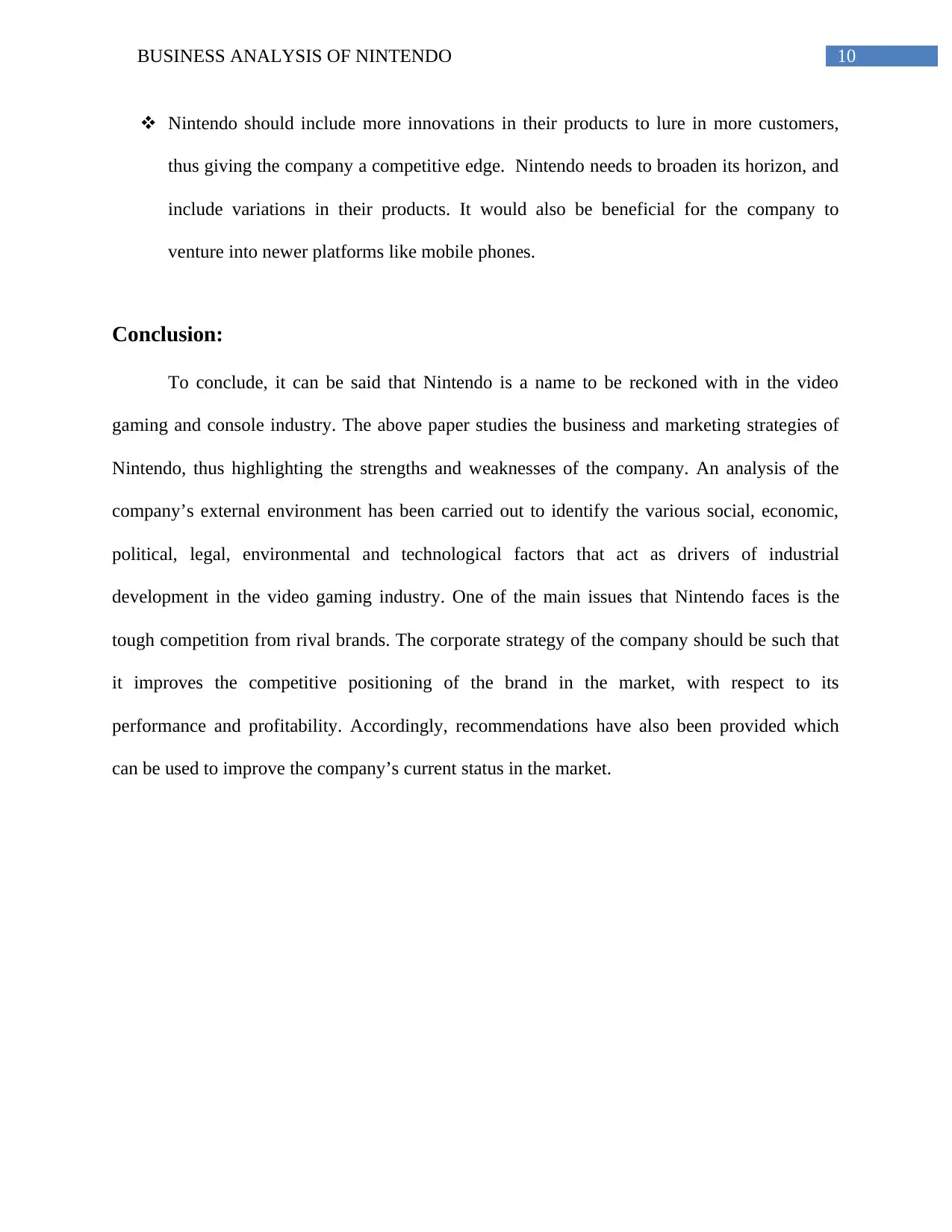
10BUSINESS ANALYSIS OF NINTENDO
Nintendo should include more innovations in their products to lure in more customers,
thus giving the company a competitive edge. Nintendo needs to broaden its horizon, and
include variations in their products. It would also be beneficial for the company to
venture into newer platforms like mobile phones.
Conclusion:
To conclude, it can be said that Nintendo is a name to be reckoned with in the video
gaming and console industry. The above paper studies the business and marketing strategies of
Nintendo, thus highlighting the strengths and weaknesses of the company. An analysis of the
company’s external environment has been carried out to identify the various social, economic,
political, legal, environmental and technological factors that act as drivers of industrial
development in the video gaming industry. One of the main issues that Nintendo faces is the
tough competition from rival brands. The corporate strategy of the company should be such that
it improves the competitive positioning of the brand in the market, with respect to its
performance and profitability. Accordingly, recommendations have also been provided which
can be used to improve the company’s current status in the market.
Nintendo should include more innovations in their products to lure in more customers,
thus giving the company a competitive edge. Nintendo needs to broaden its horizon, and
include variations in their products. It would also be beneficial for the company to
venture into newer platforms like mobile phones.
Conclusion:
To conclude, it can be said that Nintendo is a name to be reckoned with in the video
gaming and console industry. The above paper studies the business and marketing strategies of
Nintendo, thus highlighting the strengths and weaknesses of the company. An analysis of the
company’s external environment has been carried out to identify the various social, economic,
political, legal, environmental and technological factors that act as drivers of industrial
development in the video gaming industry. One of the main issues that Nintendo faces is the
tough competition from rival brands. The corporate strategy of the company should be such that
it improves the competitive positioning of the brand in the market, with respect to its
performance and profitability. Accordingly, recommendations have also been provided which
can be used to improve the company’s current status in the market.
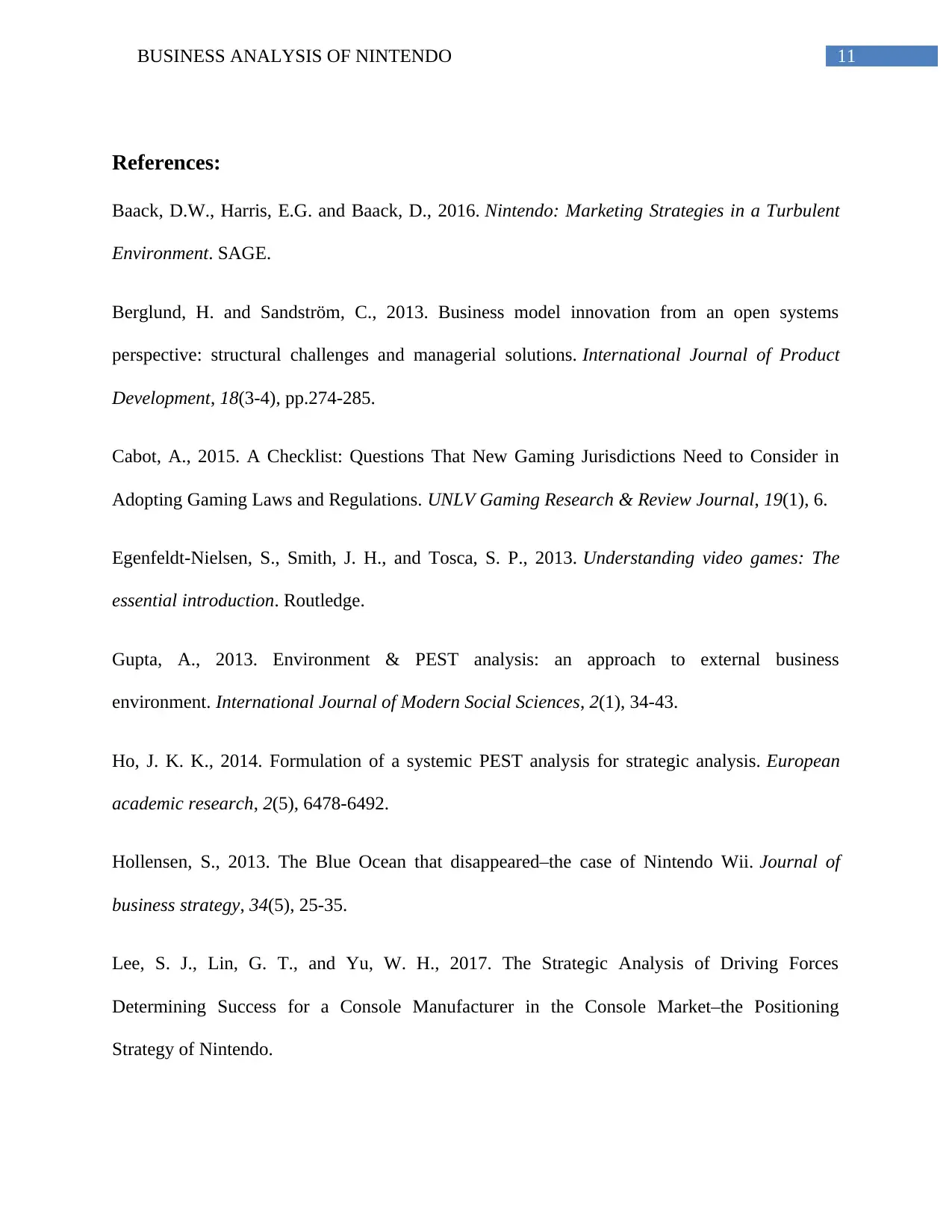
11BUSINESS ANALYSIS OF NINTENDO
References:
Baack, D.W., Harris, E.G. and Baack, D., 2016. Nintendo: Marketing Strategies in a Turbulent
Environment. SAGE.
Berglund, H. and Sandström, C., 2013. Business model innovation from an open systems
perspective: structural challenges and managerial solutions. International Journal of Product
Development, 18(3-4), pp.274-285.
Cabot, A., 2015. A Checklist: Questions That New Gaming Jurisdictions Need to Consider in
Adopting Gaming Laws and Regulations. UNLV Gaming Research & Review Journal, 19(1), 6.
Egenfeldt-Nielsen, S., Smith, J. H., and Tosca, S. P., 2013. Understanding video games: The
essential introduction. Routledge.
Gupta, A., 2013. Environment & PEST analysis: an approach to external business
environment. International Journal of Modern Social Sciences, 2(1), 34-43.
Ho, J. K. K., 2014. Formulation of a systemic PEST analysis for strategic analysis. European
academic research, 2(5), 6478-6492.
Hollensen, S., 2013. The Blue Ocean that disappeared–the case of Nintendo Wii. Journal of
business strategy, 34(5), 25-35.
Lee, S. J., Lin, G. T., and Yu, W. H., 2017. The Strategic Analysis of Driving Forces
Determining Success for a Console Manufacturer in the Console Market–the Positioning
Strategy of Nintendo.
References:
Baack, D.W., Harris, E.G. and Baack, D., 2016. Nintendo: Marketing Strategies in a Turbulent
Environment. SAGE.
Berglund, H. and Sandström, C., 2013. Business model innovation from an open systems
perspective: structural challenges and managerial solutions. International Journal of Product
Development, 18(3-4), pp.274-285.
Cabot, A., 2015. A Checklist: Questions That New Gaming Jurisdictions Need to Consider in
Adopting Gaming Laws and Regulations. UNLV Gaming Research & Review Journal, 19(1), 6.
Egenfeldt-Nielsen, S., Smith, J. H., and Tosca, S. P., 2013. Understanding video games: The
essential introduction. Routledge.
Gupta, A., 2013. Environment & PEST analysis: an approach to external business
environment. International Journal of Modern Social Sciences, 2(1), 34-43.
Ho, J. K. K., 2014. Formulation of a systemic PEST analysis for strategic analysis. European
academic research, 2(5), 6478-6492.
Hollensen, S., 2013. The Blue Ocean that disappeared–the case of Nintendo Wii. Journal of
business strategy, 34(5), 25-35.
Lee, S. J., Lin, G. T., and Yu, W. H., 2017. The Strategic Analysis of Driving Forces
Determining Success for a Console Manufacturer in the Console Market–the Positioning
Strategy of Nintendo.
⊘ This is a preview!⊘
Do you want full access?
Subscribe today to unlock all pages.

Trusted by 1+ million students worldwide
1 out of 13
Related Documents
Your All-in-One AI-Powered Toolkit for Academic Success.
+13062052269
info@desklib.com
Available 24*7 on WhatsApp / Email
![[object Object]](/_next/static/media/star-bottom.7253800d.svg)
Unlock your academic potential
Copyright © 2020–2025 A2Z Services. All Rights Reserved. Developed and managed by ZUCOL.





